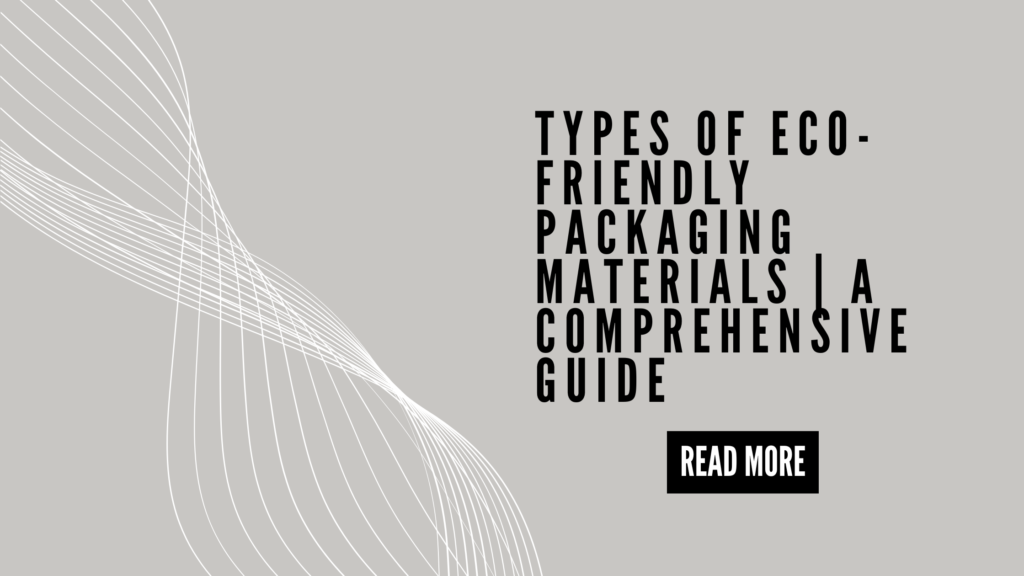Eco-friendly packaging materials play a crucial role in minimizing environmental harm and advancing sustainability in the packaging sector. As concerns about pollution and climate change intensify, more businesses are shifting toward greener and more sustainable alternatives.
Below are some notable types of eco-friendly packaging materials:
Biodegradable Plastics:
Biodegradable plastics are crafted from renewable natural resources like corn starch, sugarcane, or potato starch. These materials are engineered to decompose naturally with the assistance of microorganisms, significantly lowering their long-term environmental impact by breaking down much faster than traditional plastics.
Key Advantages:
- Helps minimize plastic pollution.
- Can be composted under appropriate conditions.
- Ideal for food packaging and single-use items.
Recycled Cardboard and Paper:
· Corrugated Cardboard: Widely utilized in packaging, corrugated cardboard is crafted from renewable wood fibers. It is both recyclable and biodegradable, making it a preferred option for shipping boxes and retail packaging.
· Kraft Paper: Derived from wood pulp, Kraft paper is known for its strength and biodegradability. Commonly used for packaging, wrapping, and bags, it involves fewer chemicals in its production compared to bleached paper.
· Recycled Paper: Utilizing previously recycled paper minimizes the demand for virgin materials, helping to preserve forests and save energy. It is a versatile material often used for packaging applications, including boxes and wrapping paper.
Corrugated Packaging:
Corrugated cardboard is an eco-friendly choice for shipping heavy or delicate items, thanks to its layered design, which offers exceptional strength and cushioning.
Key Advantages:
- Highly durable and sturdy.
- Fully recyclable and frequently produced using recycled materials.
- Adaptable to a wide range of packaging requirements.
Compostable Packaging:
Compostable materials, derived from plant fibers, fully decompose into organic matter when composted. Common examples include bagasse, a sugarcane byproduct, and mushroom-based packaging.
Key Advantages:
- Breaks down without leaving harmful residues.
- Compatible with industrial composting and, in some cases, home composting.
- Perfect for food containers, cutlery, and wraps.
Glass:
Glass is a sturdy, reusable, and endlessly recyclable material widely used for packaging food, beverages, and cosmetics. Its inert properties ensure it does not interact with the contents.
Key Advantages:
- Fully recyclable with no degradation in quality.
- Creates an airtight seal to maintain freshness.
- Non-toxic and safe for storing food.
Aluminum:
Aluminum is a highly recyclable material frequently used for items like cans, foils, and food trays. Recycling aluminum consumes significantly less energy than producing it from raw resources.
Key Advantages:
- Lightweight yet durable.
- Ideal for preserving food and beverages.
- Can be recycled indefinitely without quality loss.
Plant-Based Plastics:
Plant-based plastics, also known as bio plastics, are derived from renewable resources such as corn, cassava, or sugarcane. They offer similar functionality to conventional plastics but are biodegradable or compostable.
Key Advantages:
- Decreases dependence on fossil fuels.
- Versatile and applicable to a wide range of uses.
- Certain types are compatible with industrial composting.
Fabric Packaging:
Reusable fabric bags or wraps crafted from materials like cotton, jute, or hemp serve as excellent substitutes for single-use plastic bags. They are especially favored for gift wrapping, grocery shopping, and various retail applications.
Key Advantages:
- Long-lasting and reusable.
- Biodegradable when made from natural fibers.
- Attractive and customizable to suit different needs.
Edible Packaging:
Edible packaging materials, made from substances like seaweed, rice paper, or other edible ingredients, offer an innovative solution to waste reduction. They are commonly used for packaging food items such as candy wrappers or beverage pods.
Key Advantages:
- Produces no waste.
- Enhances the product experience.
- Made from natural, renewable resources.
Beeswax Wraps:
Beeswax wraps are a sustainable and biodegradable replacement for plastic wraps. Crafted by coating cotton fabric with beeswax, they are perfect for wrapping food such as fruits, vegetables, or sandwiches.
Key Advantages:
- Can be reused multiple times.
- Naturally resistant to bacteria.
- Compostable once they reach the end of their lifespan.
Air Pillows Made from Recycled Materials:
Air pillows are used as protective fillers in shipping boxes. Modern eco-friendly options are made from recycled materials and are biodegradable or compostable.
Key Benefits:
- Lightweight and effective for cushioning.
- Reduces packaging waste.
- Some are compostable after use.
Conclusion:
Selecting eco-friendly packaging materials is a crucial move towards sustainability. By choosing materials such as biodegradable plastics, paper, glass, and plant-based options, we help reduce waste, conserve natural resources, and lessen pollution. As technology and innovation progress, we can anticipate even more sustainable solutions to arise, simplifying the adoption of eco-friendly packaging practices for businesses.

